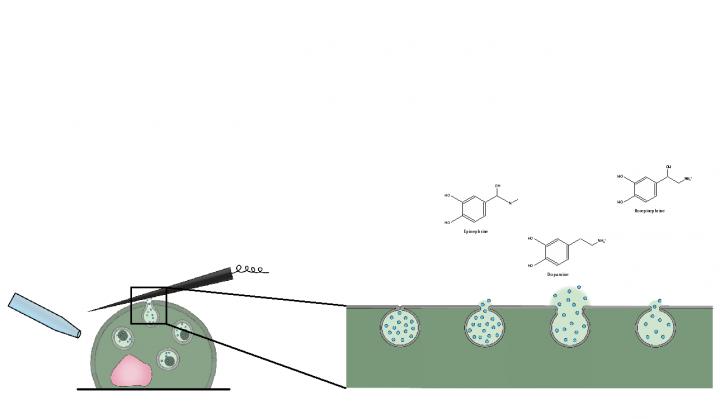
Credit: Anna Larsson
How cells communicate is the focus of a new thesis from the University of Gothenburg. “By studying mammalian cells, as well as fruit fly nerve cells, we’ve improved our understanding of how cells communicate,” says thesis author Anna Larsson.
In order to survive, the cells in our body need to be able to communicate with each other. One way for them to “talk to each other” is to send a chemical signal from one cell to another by secreting molecules. The recipient cell interprets the message and can adapt depending on the meaning of the signal.
Signal strength can vary
The actual process occurs as a cell organelle, which is well stocked with what we might call “signal molecules”, fusing with the cell membrane in a process called exocytosis.
“Several studies have shown that this process does not happen through the secretion of all the content, as was previously thought. An important discovery is that the cell can modify how strong the signal will be,” says Anna Larsson.
The process can be compared to how people communicate.
“We can talk in a normal tone, a shout or a whisper. These methods vary in their suitability based on the situation. But even if we now know that cells can modify the strength of their signal, there’s a lot we don’t know about how the strength is chosen and what factors influence the cell to shout or whisper, so to speak.”
Energy, medications and activity affect signal strength
In her thesis, Anna Larsson used different methods to study the mechanisms that take place at the molecular level, behind the regulation of the chemical signal.
“Our results indicate that proper regulation of signal strength is extremely important. An array of different factors, such as energy access, medications and activity affect both the strength and how the cell can avoid becoming ‘hoarse’ when it communicates intensely.”
Regulation of the signal appears be a widespread phenomenon. Anna Larsson and her fellow researchers have come to this conclusion in mammalian cells, which they cultivated in a lab, and fruit fly nerve cells, which they also studied.
“Identifying the different steps is important to understand how cells communicate on a fundamental level and the significance of that for our understanding of how memories are formed, for example. This information may also be used to find new molecular mechanisms as targets to create medications for diseases in which cell communication has gone awry.”
###
Thesis title: Electrochemical and Microscopic Analysis of Chemical Signalling in Biological Systems
Link to thesis: http://hdl.
Media Contact
Anna Larsson
[email protected]
46-070-993-3365
Original Source
https:/




